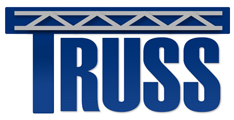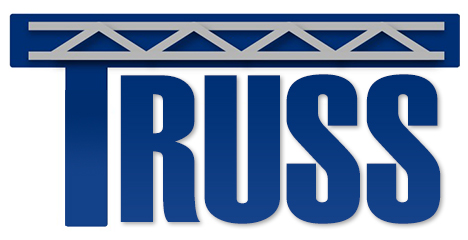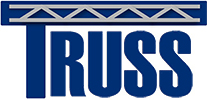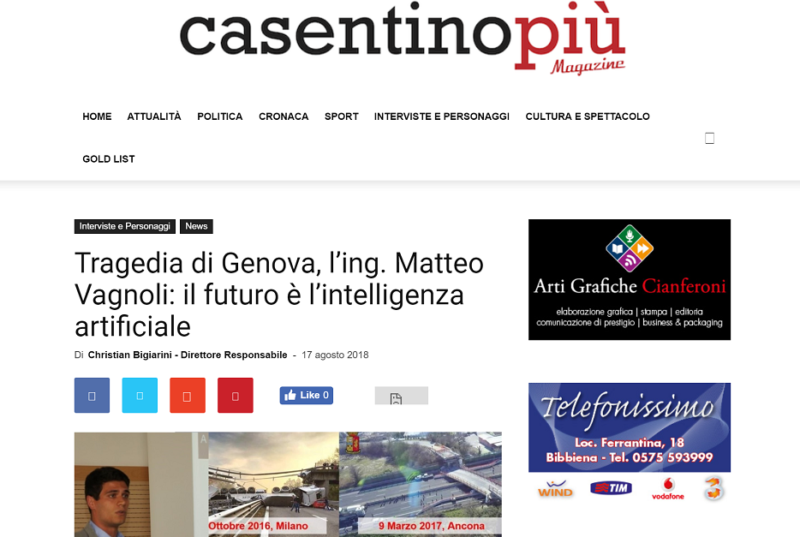Following the collapse of the Genoa bridge, Matteo Vagnoli (ESR9) was interviewed again by Casentino più, this time by Christian Bigiarini – magazine director, for their 2018 August issue, this time about artificial intelligence and structural health monitoring. The article, titled “Tragedy of Genoa, Eng. Matteo Vagnoli: the future is artificial intelligence”. An English translation of the article can be found below:
Matteo Vagnoli, born in 1989, is a young Casentinese nuclear engineer. He is currently about to conclude a PhD funded and supported by the European Union at the University of Nottingham (UK), and what he has done over the last three years is studying and developing methods of artificial intelligence for the continuous monitoring of infrastructures ( for example, he developed artificial intelligence methods to monitor and predict the health status of three facilities in the UK, Japan and Austria). We were intrigued by a post on Facebook that referred to the tragedy of Genoa and what could be done to continuously monitor the large infrastructure trying to minimize the risks of collapses, subsidence and damage. We had already interviewed him in the past to talk about his brilliant career as an engineer abroad (more details here), we felt it was right to contact him now to try to understand what his studies consist of and what practical applications they could have. Here’s what he explained to us.
Christian: Matteo, what is your job and how could it be applied to large infrastructures (bridges, viaducts and so on) to increase the safety of all of us?
Matteo: We are in 2018, we have sensors that collect thousands of data every second and we have at our disposal an ever more performing computing capacity, which allows us to develop artificial intelligence methods able to monitor, in real time, our systems (power plants, cars, planes, trains, financial market, etc.). Moreover, thanks to the so-called machine learning algorithms are able to improve themselves more and more independently. This means that the algorithms are able to learn the behavior of a system by analyzing the data collected by monitoring the system itself, and are therefore able to predict the future behavior of the system and verify if everything is working properly.
Christian: As a rule, how are these methods used?
Matteo: These methods of artificial intelligence and machine learning are used daily by Google to show us the advertisements on various sites, from Facebook and Instagram to show us on the bulletin only what we can interest, from Amazon to direct us to a particular product, from finance to identify excellent investment assets, in engineering to monitor the health status of critical systems, such as power plants, power distribution networks, aeroplanes (whose engines are continuously monitored …), etc.
Christian: And what about the infrastructure?
Matteo: Regarding the infrastructures, it is necessary to take into consideration the fact that normally the inspections and monitoring of the health of the structure is done at predetermined time intervals, from 1 to 5 years, at least from what I have learned in these three years of research. If the structure then presents some critical issues, then real-time monitoring systems are installed (sometimes) on the damaged point, so as to monitor it as long as maintenance is not performed. However, academic research over the past 10/15 years has amply demonstrated that methods of artificial intelligence (where a sensor system is installed on the infrastructure, the collected data are analyzed by algorithms to evaluate the conditions of the infrastructure and, if everything is as a rule, predicting the future conditions of the infrastructure, otherwise if the algorithm detects an anomaly, launch an alarm) can greatly increase the security and reliability of the infrastructures. Not only that, these methods also allow a great economic saving for the infrastructure manager, as this approach allows to move from a scheduled maintenance regime (I do maintenance or visual inspections by sending qualified personnel on site every few years) to a regime of predictive maintenance (I do maintenance only when the infrastructure really requires it). The savings can be really significant, because the manager of the structure is aware of the condition of the structure on an ongoing basis, and therefore can optimize its economic resources.
Christian: In your opinion, could a system of artificial intelligence avoid the Genoa tragedy and the collapse of the Morandi Bridge?
Matteo: Obviously I am not able to comment on the fact of Genoa, or similar cases, because I am not a civil engineer (but I am a Nuclear Engineer with a doctorate in artificial intelligence for infrastructure risk monitoring and analysis), so I do not have the knowledge to make comments, and I would never allow myself to launch into assumptions and hypotheses. I would not even say that with these methods the Genoa disaster could have been avoided, because these methods provide information to the infrastructure managers, then obviously it is up to them to take decisions on maintenance actions. I’m just saying that in many areas of our daily lives we are already using all these ideas, and therefore I hope that in future all the structures will be connected to each other, and we could monitor them continuously in a safe and reliable way.






